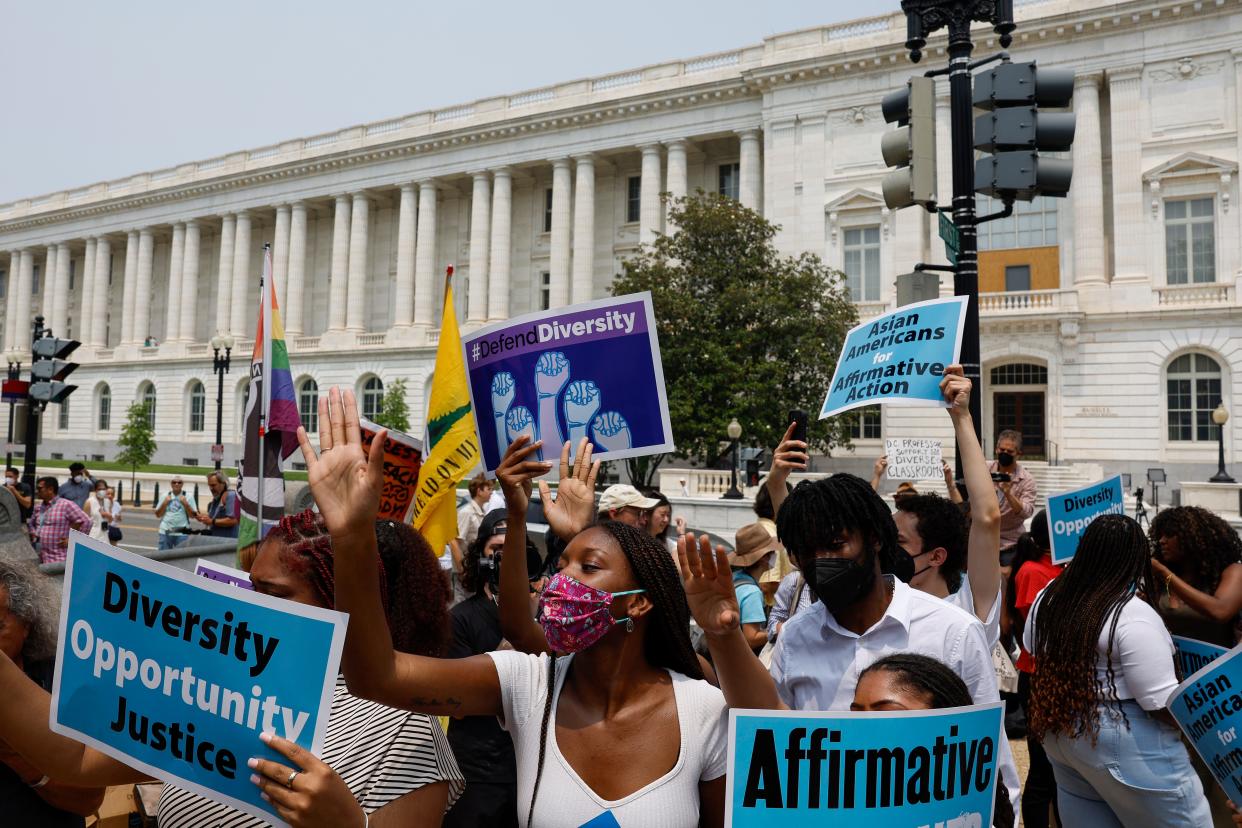Letters: Kentucky students getting ready for college weigh in on Affirmative Action ruling

From lengthy FAFSA applications to the pressure to compile your life story within a 500-word essay, students in the midst of the college admissions process often find themselves exhausted, hoping their strengths shine through their admissions files. For some students, this already arduous process just got even more complicated.
Last month, over 60 years of precedent was overturned when the Supreme Court ended race-conscious admissions at colleges nationwide. For Zoë Newsome, a Black student at the Walden School, the SCOTUS decision is disheartening: “The United States of America is starting to be, yet again, the hardship situation people want to get [away] from.”
Moving forward, colleges will have to rethink how they will ensure diversity within their student bodies. A week after the decision, we, four Kentucky high school students, reflect on the decision through the lens of identity.
Lawmakers must listen to young people since Affirmative Action ruling affects us most
Some Americans feel that SCOTUS’s decision is pushing college admissions in the right direction. They believe affirmative action was unjust as schools placed diversity at a higher standard than merit.
However, supporters of the SCOTUS decision fail to recognize the inequities already embedded in college admissions. Namely, legacy applicants. Now that affirmative action’s prohibition is in place, marginalized students will be stripped of benefits while privileged students continue to have a pipeline into elite schools. If our judicial branch deems affirmative action as an unfair advantage, it should follow the same logic with privileged groups.
Means like affirmative action are viable and essential solutions to our nation’s systemic inequalities. In order to understand the impacts of the SCOTUS ruling, the nation must open their minds to the experiences of those this decision directly affects: young people.

Anna Sugg, Senior at Sacred Heart Academy
I used to think the United States represented opportunity. Not any more.
As a Latina, I am aware of my community making up a minority of college students (32% ages 18-24 are enrolled at least part-time) in the U.S. Even so, more differentiates us when it comes to college admissions. As an immigrant, language, educational and cultural differences are all hardships intertwined with my mixed race. Due to the affirmative action ruling, the same experiences that influence my life and are embedded in my identity will be scraped away once I apply to colleges.
Growing up, I viewed the U.S. as the quintessence of opportunity. However, my previous perspective has become unreliable. When affirmative action was banned in California in 1996, Black and Hispanic student representation at UC Berkeley dropped by around 50% immediately following the ban. If our systems undermine equity by eliminating affirmative action, the country itself is branching off from supporting diverse post-secondary education. This makes me reluctant to apply to certain colleges in the future. I value exposure to diverse communities just as much as I value hard work.

Luisa Sanchez Almenarez, Sophomore at Boyle County High School
Affirmative Action ruling adds more confusion to college applications
This decision only adds more confusion to the headache-inducing process of college applications. Justice Ketanji Brown Jackson wrote, “...deeming race irrelevant in law does not make it so in life.” As a Latinx student, I fear this ruling could be interpreted to mean racism is a thing of the past and could ultimately decrease the broader push for diversity, equity and inclusion initiatives in schools and workplaces. Chief Justice John Roberts stated, “Nothing in this opinion should be construed as prohibiting universities from considering an applicant’s discussion of how race affected his or her life,” but there is little information on how exactly universities are going to implement this in post-affirmative action admissions.
When affirmative action was banned in California’s public universities, the UC system looked to other methods to achieve diversity. They instituted Eligibility-in-the-Local-Context policies, holistic and comprehensive reviews and became test-optional, all of which sought to evaluate students within the context of the opportunities they were afforded. Even with these half-a-billion dollar efforts, the system is still struggling to achieve its diversity goals. After the SCOTUS ruling, will more institutions take steps to mirror California’s techniques? If so, how long will that take, and what will be the cost? I am anxious to see what this will mean for me and students across the country who are at the cusp of the admissions process.

Anna Marasco Quibrera, Senior at Paul Laurence Dunbar High School
Asians-Americans were weaponized
In the midst of his impending failure in Fisher v. University of Texas — an early attack on affirmative action — Edward Blum, the litigator, sought a face that would form a compelling argument in the courtroom. He found it in Asian-Americans, openly saying in 2015: “I need Asian plaintiffs.” Playing upon the model minority myth that surrounds Asian-Americans, and capitalizing upon meritocratic values found in many Asian cultures, Blum crafted an “anti-discrimination” argument that, ironically, overturned a piece of policy crucial to uplifting minorities.
This was not the first case centered around Asian-American representation in higher education. In the 1980s, UC Berkeley professor Ling-Chi Wang formed the Student Coalition for Fair Admissions to fight anti-Asian discrimination in the California college system, and, ultimately, UC Berkeley admitted to discrimination. Wang’s movement had a clear influence on Blum, evidenced by Blum’s citation of arguments from Wang’s cause. But unlike Blum, Wang was and is an outspoken supporter of affirmative action, and his activism has revolved around the dichotomy of privilege between wealthy white students and underrepresented Asian-American students. The narrative that suggests Asian-American students are harmed when Black and Latinx students succeed is a twisted, zero-sum framing propagated by Blum.
Blum claimed to speak for Asians. In truth, we were weaponized.

Sara Nath, Senior at Ryle High School and Gatton Academy
This article originally appeared on Louisville Courier Journal: Kentucky students ready for college weigh in on Affirmative Action

